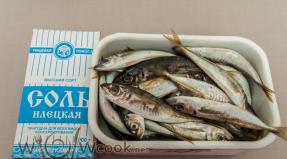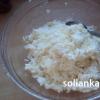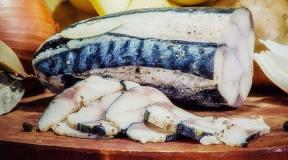What are saganaki. Saganaki Greek Cheese Snack
One of our family favorites is Saganaki Shrimp Cretan. Since I am a shrimp lover, shrimps do not come out of my refrigerator. In late autumn (October-November) shrimps are caught in Crete and you can buy fresh shrimps for 2-3 euros per kg. Usually in a fish store they are from 9 Euros and more per kg. I usually buy 20 kg of freshly caught shrimp, peel them, boil some immediately, and send them raw in portions to deep freeze. And then, as needed, I defrost it and use it to prepare various dishes.
In Crete, it is a sin not to cook seafood dishes, since there are a lot of them in traditional Cretan cuisine.
We won't sin, we'd better cook!
For the preparation of Saganaki shrimps, we need, first of all, shrimps. It is advisable to have shrimp in two sizes: small and large. We will use small shrimps for the dish itself, and large ones (they are also called "Royal") we will use for decoration. It was only in Crete that I learned from the Cretans that the smaller the shrimp, the richer its taste. Therefore, I often use small shrimps in my dishes.
As you can see, I have frozen shrimp. I defrosted them beforehand.
You will need onions, tomatoes, bell peppers (I usually don't put it, you decide), feta cheese, seasonings: oregano and basil, olive oil.

Let's get down to the cooking process:
Tomatoes should be very ripe, almost ripe, they will give a beautiful color to your dish. We grate tomatoes. Make sure there are no tomato peels.

Add oregano and basil to the tomato puree, pass the garlic through the garlic and also add to the puree.

Knead feta cheese into small pieces

And add feta to the sauce.

Chop the onion very finely.

Fry the onions in olive oil until golden brown.

We send the fried onions to the sauce and mix everything.

Put the shrimps in an even layer in a fireproof dish in which you will bake the shrimps.

Fill our shrimps with sauce, the sauce should completely cover the shrimps, and decorate with large king prawns.

Sprinkle our dish with parsley on top. We preheat the oven to 170 degrees C and send our form into it for 30 minutes.

This is how the prepared dish "Saganaki Shrimp" in Cretan looks like. Very aromatic and tasty. Anyone who loves seafood in general and shrimp in particular will like it.

It is customary to serve this dish with white soft fresh bread, so that this bread can then be soaked with a very tasty sauce.

Cooking time: PT00H50M 50 min.
Do you love shrimp the way I do?)
At the time when I just got carried away with Greek cuisine and wooled the Internet in search of authentic recipes and those dishes that can be prepared without much prejudice to the correct taste from the products available in the shops of a small Russian city, I came across arrogant posts several times. .. that frozen seafood is fu and ba, that you only need fresh, otherwise byaka-kaka is not the same at all. Sorry, but as for me, it's better frozen than nothing at all. I lived 45 years in the north - we would have fun there if we counted only on fresh food and turned up our noses from frost and canned food ...
But to the point. Today on our agenda garides saganaki (Γαρίδες σαγανάκι)- that is, shrimp in tomato sauce.
Basic ingredients: shrimps, tomatoes or tomato paste, onions, garlic, olive oil, herbs, salt, pepper, paprika or bell pepper, feta cheese.
So let's get started. In terms of quantity, I will proceed from 0.5 kg of unpeeled shrimp. And then we need a couple of large tomatoes or the corresponding amount of tamat paste, 1-2 medium onions, 1-2 cloves of garlic, the rest is at our discretion.
 Shrimps cook (unpeeled or peeled - at your discretion). If cooked peeled, peel. Do not pour out the broth! Chop the onion and put in a frying pan to sauté. Peel the tomatoes and chop finely or twist in a blender - and put in onions. Add squeezed garlic and finely chopped pepper (or dry paprika), herbs, salt and pepper there. Saute lightly (no more than 3-5 minutes) and pour the shrimp broth into it (from half a glass or more, depending on how you want to see the result - very thick or in the form of a thick soup).
Shrimps cook (unpeeled or peeled - at your discretion). If cooked peeled, peel. Do not pour out the broth! Chop the onion and put in a frying pan to sauté. Peel the tomatoes and chop finely or twist in a blender - and put in onions. Add squeezed garlic and finely chopped pepper (or dry paprika), herbs, salt and pepper there. Saute lightly (no more than 3-5 minutes) and pour the shrimp broth into it (from half a glass or more, depending on how you want to see the result - very thick or in the form of a thick soup).
Mix, let saturate a little - over low heat. And then either put the shrimps in a frying pan (if it is deep) or shrimps in a cauldron or other suitable dish, and on top - sauce. Stir, let it brew, sprinkle with torn feta and herbs before serving.
 Variations:
Variations:
- After mixing the shrimp with the sauce, sprinkle this thing with feta and send it to the preheated oven for 5-8 minutes (focus on baking the cheese), do not close the lid.
- Do not cook shrimp, but fry
- Fry / simmer the shrimps in the onion-garlic mixture, and add the rest of the ingredients a little later.
- Stew the shrimps in a ready-made sauce (in this case, you need tomatoes, not tomato paste and add water if necessary, because when stewing shrimps, the sauce should be liquid, and there should be a lot of it). Then pick feta there and either just let it brew under the lid, or send it to the oven without the lid. For about 5 minutes or so.
- Others cook gardies saganaki with unpeeled or partially peeled shrimp.
And we have only one open question - what method of cooking shrimp to choose? Should I clean them immediately or after cooking? Or not clean? Fry, boil or simmer? Before I got acquainted with Greek cuisine, I did not ask such questions and always just boiled it unpeeled, and cleaned it later. Or bought already peeled and boiled them. But it turned out that there are many ways. More about this in the next episode)))
The Greek dish saganaki brings together a whole class of dishes cooked in the flat saganaki pan. Just like in the Valencian paella flat pan, you can make a wide variety of paella types (see here).
The classic saganaki is a pan-fried Greek cheese, halloumi or feta. Garides saganaki is a more complex dish: the king prawns are flamed in ouzo, then stewed a little in tomato sauce, and at the final stage they are baked in the oven to slightly melt the feta cheese.

Shrimp flambé in ouzo
I do not have a saganaki pan on my farm, but I have successfully replaced it with a two-handed copper pan that I once bought in Portugal.

Portuguese two-handed frying pan
Ingredients:
- 12 large shrimps;
- 4 ripe tomatoes;
- 80 ml olive oil;
- 1 shallots, finely chopped
- 2 cloves of garlic, minced
- a pinch of hot pepper;
- salt, black pepper;
- 70 ml ouzo;
- 200 gr. feta cheese;
- ¼ a bunch of basil leaves;
- a pinch of oregano.
Peel the shrimp, leaving the head and tail for more flavor.
Slit the back of the shrimp and remove the black vein.
Cut the tomatoes in half and grate (no peel needed). Transfer to a strainer to drain excess liquid.
Heat 50 ml olive oil in a skillet over medium heat, add shallots and fry lightly until translucent. Add minced garlic, a pinch of pepper and salt and black peppercorns.
Place the tomato puree in the skillet, cover and cook for 5-10 minutes, or until the sauce thickens slightly and most of the liquid has evaporated.
Preheat oven to 220 C.
Sprinkle the shrimp with salt and fry in another skillet in 20 ml of olive oil over medium heat. Pour in ouzo and glaze the shrimp. (Don't be afraid if you have a flame, it will go out quickly as soon as the alcohol evaporates).
Shrimp saganaki (garides saganaki) is a Greek dish, shrimp in red sauce. I saw this recipe in a magazine from the chef of one of the hotels in Greece, and gladly decided to try shrimp in this version. Saganaki shrimp can be attributed to hot appetizers or to an independent main course.
To prepare shrimp according to this recipe, you will need Ouzo Greek Anise Vodka. If not, you can replace it with any other aniseed vodka. At worst, cook without Ouzo. But I decided that my first time should definitely be with Ouzo.
As a result, the result exceeded my expectations. It turns out insanely delicious. Ouzo brings a hint of aniseed flavor to the sauce, while Feta cheese perfectly complements both tomatoes and shrimp. Traditionally, bread is also dipped into the sauce.
Saganaki shrimp is prepared quite simply and quickly. In the network I met cooking options with further small baking in the oven, but I decided to do without this and follow the recipe of the Greek cook. In general, this dish is prepared in a portioned saganka frying pan, but I don't have it. I think that an ordinary frying pan is also a good fit and I will cook in it, may my Greek friends forgive me.
I ended up with 1 rather large serving.
The popular Greek appetizer saganaki is inherently toasted slices of cheese. Fragrant, yes with a golden crust! Saganaki can be ordered at any tavern. The dish is very simple, and it only takes 5-10 minutes to prepare! Irina, the chef of the Athens restaurant "Barin", shared the recipe with us
Saganaki (σαγανάκι) in translation from Greek means "small frying pan". If the menu just says saganaki, don't hesitate, it's about fried cheese.
Ingredients:
- 120 g kefalotyri or graviera cheese
- vegetable oil
- half lemon
Syyyyyr!
The main catch is that any cheese is not suitable for this snack. The chef advises buying Greek mullet or graviera, but in fact, the selection of cheeses for saganaki is quite large. Here is some of them.
Kefalothiri in Greece can be bought at any grocery store. Open the Greek's refrigerator and you will almost certainly find a kefalothiri there! Hard cheese, made from sheep's or goat's milk. The dining version is less salty. There is also a kefalothiri, similar to parmesan, on the shelves of supermarkets. This cheese is very salty, so it is seasoned with salads, stewed vegetables, pasta, etc.
 Photo: Eva Kosmas Flores
Photo: Eva Kosmas Flores Graviera- sweet and salty hard cheese made from 100% sheep / goat / cow milk. Sheep milk graviera is produced in Crete, Peloponnese, in the north of mainland Greece. And from the cow (this is more common, so the geography is expanding) - on the islands of Tinos and Naxos. Pies are stuffed with cheese, it is added to meat dishes, and, of course, is served separately.
 Photo: Shutterstock
Photo: Shutterstock Formaela- a very fatty medium-hard cheese. Sheep and goats, whose milk is used to make it, live and graze in the meadows of Mount Parnassus. Formaela is the perfect cheese for frying!
 Photo: Robert Wallace
Photo: Robert Wallace Halloumi- traditional semi-hard Cypriot cheese. Previously, it was made exclusively from sheep's milk, now, in most cases, it is made from cow's milk. Mint is used for cooking, so halloumi has a special taste. It is a bit like a mixture of Suluguni and Adyghe.
 Photo: Shutterstock
Photo: Shutterstock For everything about everything 10 minutes!
With the cheese sorted out - let's start cooking! Cut the cheese into 1.5 cm thick slices. Sprinkle them with water, roll in flour (do not forget to shake off the excess!) And send them to a preheated frying pan with butter. Please note that the butter should cover 1/3 of the pieces. Fry the cheese on both sides until golden brown.
 Photo: Michaela Ristaino
Photo: Michaela Ristaino Serve saganaki hot and always with half a lemon! Lemon is squeezed onto cheese already at the table. You can also season the appetizer with tomatoes, lettuce and herbs.



















